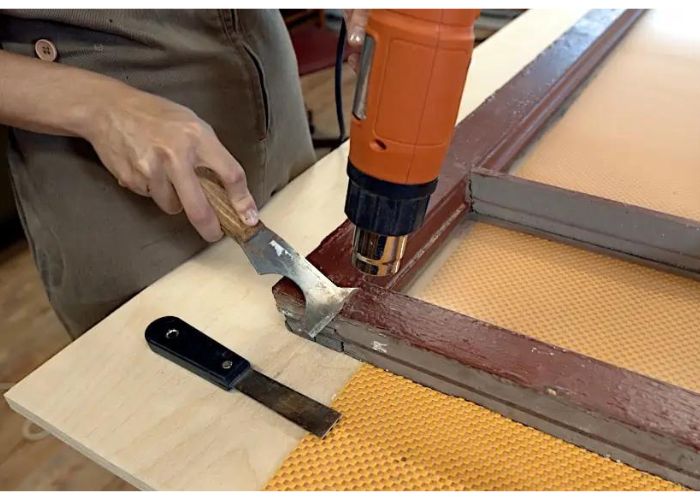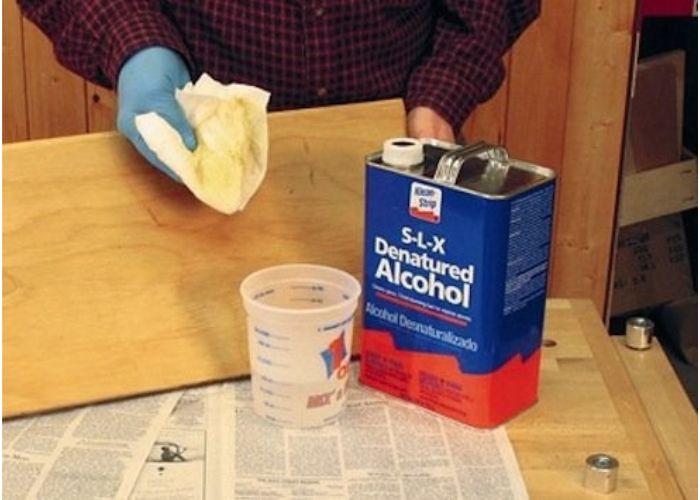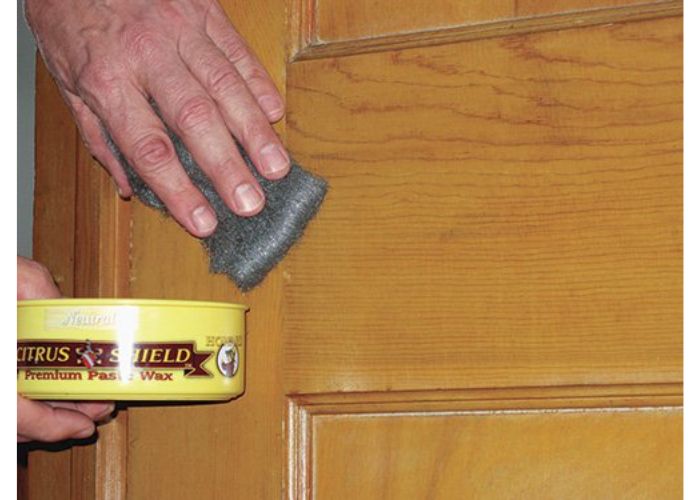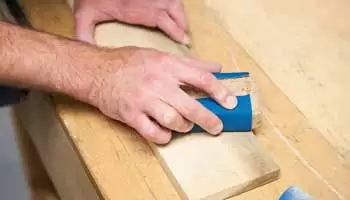Lacquer is one beautiful durable finish – no doubt about that. But, like many other finishes, it may begin to wear off and stain after a while.
You have to think of solutions, the most typical of which is to remove the lacquer from wood. However, removing lacquer from wood isn’t easy because lacquer sticks tightly to wood.
While it is difficult, it is doable with the right methods and techniques. In this guide, we will walk you through how to remove lacquer from wood using lacquer remover.
How to Remove Lacquer From Wood
Use denatured alcohol to remove lacquer from wood. This method is the easiest for removing alcohol-based finishes like lacquer as the solvent is right in your neighborhood. Unless alcohol doesn’t work, go for lacquer thinner. Apply the thinner to loosen the finish on your surface, then use a putty knife to scrape off the residue.
Lacquer binds strongly to wood surfaces. This is good in one respect as it means the finish lasts long on the wood.
However, it also means it becomes a huge bother to remove the lacquer coat from wood.
You also need to be sure that the finish you have on your furniture is lacquer and not polyurethane. You can check the difference between polyurethane and lacquer before assembling your tools.
Also, make sure to find a well-ventilated room where you will carry out the removal process. Ventilation is a critical aspect of removing lacquer because of the fumes and dust emanating from the processes. If you can, perform the process outdoor.
After removing the lacquer coat from the wooden furniture, you can reapply a new finish or coat. All waste products or rags used in the process should be disposed.
Related read: Can you put clear coat over lacquer?
Tools for Removing the Lacquer Coat

Below are the tools that are generally needed to remove lacquer from wood.
- Rubber gloves
- Clean cloth
- Denatured alcohol
- Lacquer thinner
- Scraper and steel wool
- Scouring pad
- Putty or plastic knife
- Spatula
- Baking soda
- Respirator mask or dust mask
- Cotton balls
- Heat gun
- Mineral spirits
- Old rag
- Sandpaper
- Sanding block
- Acetone
- Plastic bag
- Turpentine
- Wire brush
How to Remove Lacquer from Woodwork
There’re many methods for removing lacquer from wood, but they usually fall into two broad groups – chemical and non-chemical.
As you would expect, chemical methods involve the use of strong chemical products in removing the lacquer coat.
If you’re familiar with removing finishes from wood, you may have heard of chemical strippers. Their name gives away how they operate – they strip off finishes with chemicals.
This also applies to lacquer as its resistance to chemicals isn’t good, especially as the thick coat ages.
Special care has to be taken when dealing with the chemicals because they tend to produce toxic fumes, always follow the manufacturer’s directions. Non-chemical methods include sanding, heating, and the likes.
Both methods are effective and can be used, but we will advise you to start with chemical methods as the non-chemical methods can do considerable damage to the wood if the process is botched.
This is especially true with heat and scraping. Below is a detailed step-by-step guide of the various methods you can employ to remove lacquer from wood. So let’s get straight into it, shall we?
1. The chemical solvent method

This has a strong stake for being the best method of removing lacquer from wood. This is because it is an effective, efficient, and time-saving removal method.
The lacquer finish is alcohol-based, meaning you can dissolve it in a suitable solvent like lacquer thinner and solve the problem.
You can use individual chemicals, like lacquer solvents, or chemical combinations, like denatured alcohol and lacquer thinner, as the need may be.
Steps
Get your solvent ready.
There’re commercially marketed lacquer thinner solvents that you can get and will help with removing the lacquer coat.
If you don’t get a lacquer thinner, you can use a lacquer thinner, which, along with denatured alcohol, can work just as well.
Prepare the alcohol and lacquer thinner mixture by mixing equal parts of lacquer thinner and denatured alcohol in a bowl till it thickens.
If you don’t get a satisfactory mixture, increase the ratio of the lacquer thinner to the denatured alcohol.
Apply the solvent
When your lacquer thinner is ready, the next step is to apply it. Before applying stain solvent, segment your wood into smaller parts.
This is important in getting an even and consistent layer of coat. Using a paintbrush, spread thick coats of the lacquer solvent mixture over the marked parts.
Leave to dry
The solvent should dry out fast, usually in a few minutes. Using the right solvent in the right volume means the coat will dissolve completely and come right off the surface of the wood.
If all the necessary parameters are adhered to, the lacquer coat will come off as liquid or flakes. Getting a cloudy coat form means you need to apply even more solvent to aid complete lacquer removal.
Remove the solvent and lacquer from wood
This step is quite tricky, we won’t lie, but it is a necessary one nonetheless. After your solvent might have acted on the lacquer coat and dissolved it, you need to remove both the lacquer finish and the excess solvent from the wood.
Lacquer finish will usually come off as slices and should be easy to remove. Then, using even more lacquer, you can get rid of excess solvent.
You can also use a brush for this step, but a hard-brittle brush now. Brush around in circles in the same areas you marked earlier when applying the coat.
Before long, your solvent will be all gone, and you can clean with a drop cloth after. However, if this step is successful, you will notice the wood’s characteristic shiny and smooth coat is gone.
Remove any remaining lacquer
If you still can’t get all of the solvents off using a wire brush for paint removal or medium-fine steel wool, you may need to use a putty knife.
Using the knife, remove lacquer remains, taking great care not to scratch or dent the wood in the process.
If all the solvent comes off, good news – you have reached the end of the process. If not, you need to reapply the solvent.
Repeat the process
There may be cases where lacquer remains on some spots. Again, you will need to reapply the solvent as before, but the difference now is you don’t wait for the solvent mixture to dry before using steel wool to clean it off.
After removing all of the lacquer spots, wipe the wood completely with a cloth to remove any excess solvent.
See Also: How to Eliminate Black Urine Stains From Hardwood Flooring
2. Using a chemical stripper
Another form of using chemicals to remove lacquer from woods is chemical strippers, which strip off the lacquer coat.
Now, the principle doesn’t change much, as with chemical solvents, but there are some differences in how they are used. Also, traditional paint strippers are labor intensive and don’t work as fast as strong solvents.
To start with, chemical strippers can be alkaline or solvent-based. The type of stripper you will use depends on the type of lacquer coat you want to remove.
For oily paints and lacquers, alkaline strippers will work. In addition, solvent-based paint strippers can be used for other lacquers and paints.
It is important to take extra care when working with chemical strippers and all chemicals, for that matter, as adding too much will stain the wood surface.
Remember to put on rubber gloves and the manufacturer’s instructions.
Steps
- Remove all metal fittings from the piece of furniture before starting the stripping process
- Using 150 grit sandpaper and steel wool to lightly sand the lacquered areas.
- After sanding the surface, apply the paint stripper using a plastic paint brush.
- Sand off the remaining lacquer layer with 80 grit sandpaper.
- Wipe off the wooden surface with a tack cloth after all sanding process is completed to remove remaining traces.
3. Sanding
This is one of the more popular methods of removing lacquer from wooden furniture, particularly for thin layers of lacquer. The sanding process can be done with either sandpaper or a sand machine, like an orbital sander.
Many prefer sandpaper to protect the surface of the wood from deformation. However, a sanding machine will as well work.
When sanding, ensure you put your wood on a flat surface don’t exert too much pressure or sand too hard on the wood. Then, after the lacquer finish is gone and the wood is no more slippery, you can reapply any lacquer finishes or any other varnishes or paints of your choice.
There’re different types of sandpapers to use, depending on the wood and individual. They include 80 grit sandpaper, 150 grit sandpaper, 220 grit sandpaper, etc.
You can also use this method to remove ink from wood.
Steps
- Clean the wood with a soap solution. Ensure you get out all debris and dust from the wood surface. Leave the wood to dry completely.
- Use a sanding machine or sandpaper to sand the wood. There may be certain areas where the power sander may not get, and these lacquered areas should be successfully removed using sandpaper. There is no fixed grit of sandpaper to use. Some start with 150 grit sandpaper, while others use 220 grit sandpaper. It is usually best to start with coarse sandpaper to get off as much as possible when starting out. Sanding should always be towards the wood grain and not against it. For areas where the electric sander doesn’t reach, use sandpaper or sanding block.
- After coarse sanding, finish with fine sandpaper for even smoother wood surfaces.
- Completely remove dust from the wood surface after sanding, using a paint brush and a drop cloth. Again, clean following the wood grain and not against it. Apply a new finish.
Related: How to Remove Paint from Wood without Sanding
4. Using heat
Heat is an underrated form of removing lacquer from wood. Unlike the chemical removal methods, there’s no high risk of staining the wood because there’re no chemicals involved when using heat except you burn the wood.
This method uses high temperatures to peel off and remove lacquer layers. And before you ask – you’re not going to be setting your wooden furnitures or hardwood floors on fire.
If you did that, the lacquer coat would be gone quite alright, but best believe your wood will be gone too! It would be best if you had a heat gun for controlled lacquer removal.
Steps
- Clean the surface with a clean rag and allow it to dry completely.
- Apply heat on the lacquered surface at about 15 centimeters from your wood and a 45-degree angle.
- Before long, the old lacquer coat starts to wrinkle under the influence of the heat, and this is when you can remove it with a putty knife.
- After the bulk of the lacquer layer is gone, sand the wooden surface.
Also Read: How to Get Stains Out of Hardwood Floors
5. The spatula method
Want to get lacquer off your wood furniture? Just scrape it off! That sounds like something you’ll hear in a low-budget commercial, but it works. You can scrape off multiple layers.
This has to be done carefully, not to damage the wood in any way. You can use a spatula as a scraper or purchase other scrapers in wood hardware stores.
Steps
- Clean the wood surface with a damp cloth and let it dry.
- Start scraping the lacquer layer off with short vertical and horizontal motions.
- Remove any remaining lacquer from wood with a sponge.
6. The steel wool method

Steel wool has appeared a few times over the course of this article. This shows how important it is when getting lacquer off the wood. Using steel wool is a form of scraping the lacquer coat off the wooden surface.
Steps
- Start by cleaning the surface of the wood with a warm soapy water and allow the wood to dry completely.
- Move the steel wool over the lacquer finish in small circles, taking care not to apply too much pressure.
- For the corners and crevices beyond the reach of the steel wool, use a small scraping tool.
- In the final removal process, wipe the wood surface with a tack cloth to remove all the lacquer.
Choosing the Right Chemicals for Removing Lacquer from Wood
Different types of chemicals help strip the lacquer coat off wooden furniture. To choose one to use, there’re some factors to consider.
The first is the thickness of the lacquer coat you want to remove. Thicker coats will need stronger chemical strippers and solvents.
While these chemicals will do a good job, the catch is they have more toxicity risks than weaker solvents.
So, even emphasizing the effectiveness of the chemical stripper and solvent ensure you don’t neglect its safety.
Aside from the toxicity issues, many lacquer chemical strippers are highly flammable. So again, the utmost care has to be taken to ensure the chemical used will pose the lowest danger to your health, in addition to being effective.
Furthermore, the price of the chemical has to correlate with its effectiveness. There’s no sense in spending much on chemicals that will give mediocre results.
The strongest of the chemical strippers are the methylene chloride agents. N-Methyl-2-Pyrrolidone is an alternative to methylene chloride agents.
NMP strippers aren’t as toxic as their methylene chloride counterparts but also not as strong; nonetheless, they will work well.
Then, there’re biochemical strippers, which are usually organic acids from various plants and animal sources.
These include lactic acid, citric acid, terpenes, etc. Biochemical strippers have the lowest toxicity risk of all strippers mentioned, but also not as strong as the preceding two.
The choice on which chemical stripper to use usually boils down to the nature of the lacquer coat. If the wood is old or isn’t resistant to chemical damage, then you should steer clear of the methylene chloride agents.
But if you think your wood can take it and manage all toxic products, methylene chloride agents are one way to go.
Note that the type of chemical strippers and solvents you choose for the job will go a long way in determining the eventual result of the process and getting full value for your money.
Hence, consider all important factors and make an educated choice.
Also Read: How to Remove Dark Water Stains From Unfinished Wood
Precautions When Removing Lacquer from Wood
Always wear safety gear

We can’t overemphasize this – but we’ll try anyway! Always wear safety gear when you want to remove paint or lacquer from wood.
Irrespective of the method you use, ensure your goggles and respirator mask are always on. Also, when dealing with strippers, steel wool, and solvents, ensure your rubber gloves are on.
Keep lacquer thinners far from your eyes and skin. Even when using mechanical methods, you need to be careful.
Heating lacquer can produce toxic fumes. Sanding also produces dust that may be irritating to the eyes and skin.
Carry out the removal process in a well ventilated area
This is a must anytime you remove lacquer from wood. Good ventilation is essential as there may be toxic fumes and dust from the various methods.
Open all windows or use fans – with a fan blowing into the room and the other blowing out the window. Better still, do the removal outdoors, if possible.
Dispose of rags and waste properly
After removing varnish, all the rags and waste such as steel wool should be stuffed in plastic bags and taken outdoors. Don’t leave them hanging around your house, especially if you have children around.
Protect wooden furniture
Before starting the process, remove all metal fittings and hardware from your wood and store them in a secure place.
If you are going to be removing varnish indoors, cover surrounding areas to protect from dust and lacquer residue.
Use plastic knives when using chemicals
You can use several chemicals to remove lacquer from wood. However, because of the nature of the finish, the chemicals are usually concentrated.
The high concentration makes them toxic not only to living tissues but also to metals. As such, before starting any removal process, ensure the wood is completely rid of all metal fittings.
It would be best if you also used plastic knives for removing the coat, opposed to metal knives.
FAQs
How can I remove lacquer from wood?
There’re various ways you can remove lacquer finish from wood, including chemical solvents and strippers, sanding, heat, and scrapers. You can choose one that best suits you.
How long does it take to remove lacquer from wood?
It generally depends on the method you use. Some take about 20 minutes, while others may take a few hours. The size of the lacquered area also matters.
Can I remove shellac and lacquer from wood myself?
Yes, you can remove shellac and lacquer from wood by yourself. However, if you have problems getting all of the shellac out for extended surfaces, you should check out our article “How to remove shellac” for more information.
Conclusion
Lacquer is a great finish – that’s unarguable. One of the reasons it is so loved is because it’s a durable finish and the ability to remain on wood for long without coming off or staining, even with intense wood use.
But this also means it becomes a bother if you don’t know how to remove lacquer from wood. But it is possible.
Just be careful not to damage the wood. Safety gear is an absolute must because of the potential toxicity of the methods discussed.
Check out if it’s possible to paint over lacquer without removing it if you want to refinish your lacquered piece of furniture.

